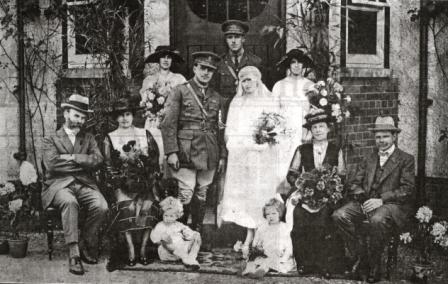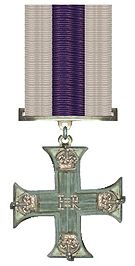Major William George DEAKIN MC
(1890 - 1954)
Major 127571 William George DEAKIN RFA, RHA was the third son of William Robert DEAKIN and Betsy HODSON. William, known to his family as Billy, was born on 25 May 1890 at 43 Poolstock Lane Wigan, Lancashire[1].
In the 1901 Census William (aged 10 years) is recorded as being a boarder at New College, Pannal, Harrogate, Yorkshire[2] with his brothers Samuel Wesley Deakin (aged 14 years) and John Bertram Deakin (aged 13 years).
After leaving school, William went to Manchester University where he studied Commerce for two years followed by two years in North America where he studied food canning in California, Chicago and Ontario. Whilst in Ontario he also worked for 6 months on railway constuction and surveying.
On returning to England, following the outbreak of the First World War, William briefly attended Cheltenham Grammar School to study for the Royal Military Academy entrance examinations. William passed the entrance exams and joined the Royal Military Academy, Woolwich as a Cadet in 1915. He was commissioned as a 2nd Lieutenant into the Royal Horse Artillery on 27 October 1915 (London Gazette 26 October 1915) and on appointment was ordered to embark with the British Expeditionary Force. William embarked for France on 5 November 1915 and joined 'K' Battery of the RHA which was attached to the 2nd Cavalry Brigade. William served in Flanders and was promoted to Lieutenant on 1 July 1917 (London Gazette 17 September 1917).
On 4 February 1918 (London Gazette 12 April 1918) William was appointed acting Captain whilst in command of 'B' Battery 223rd Brigade R.F.A. and later acting Major from 13 -21 March 1918 (London Gazette 13 June 1918).
Later in 1918, Lt. (A/Capt.) William George Deakin, RFA[4], was awarded the Military Cross[13] (gazetted 16 September 1918) for "conspicuous gallantry and devotion to duty. When heavy machine-gun fire killed several horses and men, this officer, under a hail of bullets, extricated live horses from the dead and was instrumental in saving guns, enabling the battery to come into action again an hour later."
On leave from war, William married Dorothea May BURROW in Cheltenham, Gloucestershire on Saturday 10 August 1918. The couple were married by Rev. S.S. Shrubsole B.D. at Highbury Congregational Church, Cheltenham[5]:

The above photo[11] is of Capt. William G. Deakin (centre) with his wife Dorothea May (née Burrow). Dorothea's parents Mr Edward John Burrow and his wife, Alice Elizabeth Burrow (née Fildes) are seated to the left of the bride and groom and Mr William Robert Deakin and his wife Mary Jane (née Hartley) are seated to the right. The bride was attended by Dorothea's sister Miss Beatrice Millar Burrow and Miss Bessie Deakin. Lieut. George Deakin, MC was best man (centre back) and Master Billy Deakin was the page and Miss Bunty Fildes the third bridesmaid.
Transcript of the article announcing the marriage in The Evesham Journal and Four Shires Advertiser, Saturday 17 August 1918.
William continued to serve in France until 11 November 1918. In addition to receiving the Military Cross, he was awarded the 1914-15 Star, British War Medal and the Victory Medal. He resigned his commission on 11 May 1919 but continued to serve with the Army and went on to serve during the Second World War.
William and Dorothea had the following children:
- Peter Robert Burrow DEAKIN, b. 5 Jul 1920[6], d. 23 Jan 1997[7]
- Thomas M Burrow DEAKIN, b. 1921[8], d. 14 June 1923
- William DEAKIN, b. 1922[9], d. 8 November 1922[10]
William and Dorothea lived at Toddington, Gloucestershire and William, who was appointed a director of W.R. Deakin Ltd in 1923, managed the company's jam factory and canning factory at Norton Fields, Toddington, after his Uncle George E. Deakin retired but William resigned as a director in November 1923 and moved to London.
Dorothea filed for divorce in November 1929. William and Dorothea later separated and were divorced in 1932. By June 1935, William had moved to 17 Tunnend Street, Boston, Lincolnshire. William served during the Second World War both at home and in Germany from 1945 and at the end of the war was awarded the Defence Medal.
William secondly married Majorie Fletcher in 1940 and they lived in Earls Court, London.
William died on 3 July 1954, aged 64 years, at Mountlands, Bowdon, Cheshire[12].
[1]: Source: Certified copy of birth certificate.
[2]: New College was established in 1895 in Leadhall Lane, Pannal, to the south of Harrogate in Yorkshire. New College was amalgamated in 1930 with Ashville College. The combined school at one time boasted 130 boys at Ashville and 53 at New College. New College was demolished in 1971 (photo of demolition appeared in the Harrogate Herald on 13 Jan 1971 and the site has now been developed into a housing estate.
[4]: Royal Field Artillery
[5]: Source: Register of Marriages registered in July, August, September in 1918 in Cheltenham, Vol 6a page 1041.
[6]: Source: Register of Births registered in July, August, September in 1920 in Cheltenham, Vol 6a page 862.
[7]: Source: HMCS
[8]: Source: Register of Births registered in July, August, September in 1921 in Winchcomb, Vol 6a page 752.
[9]: Source: Register of Births registered in October, November, December in 1922 in Winchcomb, Vol 6a page 625.
[10]: Source: Register of Deaths registered in October, November, December in 1922 in Winchcomb, Vol 6a page 452.
[11]: Source: Photo taken for Cheltenham Chronicle and Gloucestershire Graphic, published Saturday 17th August 1918.
[12]: Source: Certified copy of death certificate.
[13]: The Military Cross, created in 1914 for commissioned officers is the third-level military decoration awarded to officers of the British Armed Forces.
